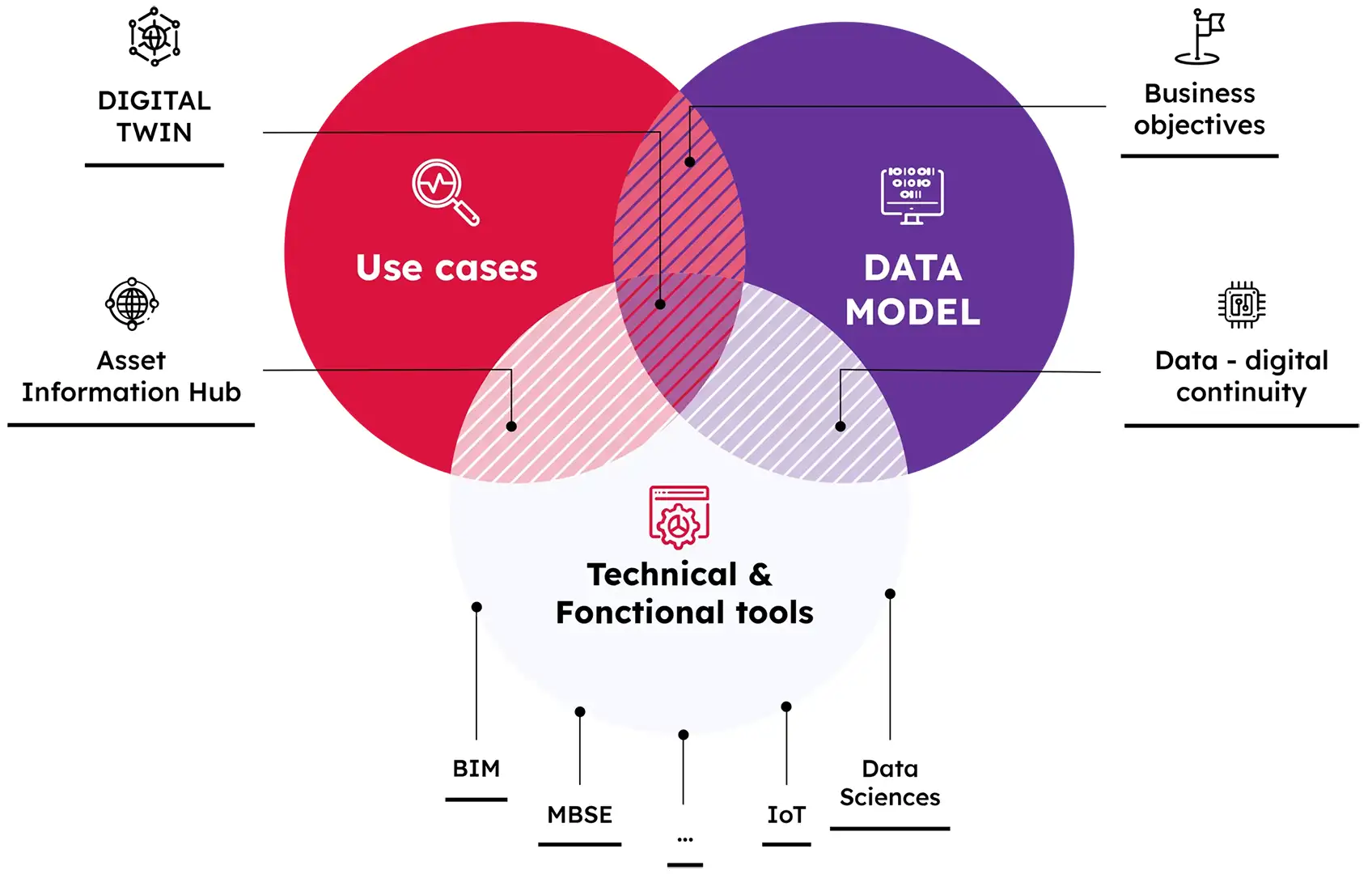Digital Twin
Context
Assystem combines its decades of complex engineering experience with its expertise in digital, to support all or part of our clients’ projects by designing, modelling, and integrating digital twin. Considered a vital part of Industry 4.0, digital twin accelerates the digital transformation of projects by addressing challenges throughout the full lifecycle of complex systems.
Digital twin provides an answer to questions around the agility, predictability and performance of industrial processes by:
- Ensuring reliable links between the tools selected and the needs expressed
- Reducing the time spent on data research and reconciliation
- Contributing to knowledge sharing of engineering data
- Enabling the exploitation of data by the most appropriate tools
- Consolidating the traceability of engineering decisions as well as control and verification (configuration management / architectural choices archive)
Digital twin: a lever for performance and competitiveness
Discover the opportunities provided by Assystem’s digital twin offer.
Digital twin: modelling and simulation of scenarios
Assystem's digital twin offer is based on:
-
Digitalisation of assets to ensure accurate control and knowledge of the environment
-
Data exploitation to collect, centralise, and analyze data
-
Modelling of assets to create digital models
-
Simulation of hypotheses to test multiple scenarios
Our approach is based on three axes:
- Technical and functional blocks that are interconnected, adapted, and adjusted in line with the project's specific requirements
- BIM - Building Information Modeling
- MBSE - Model-Based Systems Engineering
- AI - Artificial Intelligence
- Data science etc.
- The construction of data models resulting from the data produced, consumed, and exchanged throughout the project's lifecycle and adapted to the business objectives.
- A set of use cases integral to the project's requirements.
Our added value - Asset Information Hub (AIH):
Assystem’s Asset Information Hub (AIH) has been developed a knowledge base dedicated to the development of digital twin. Based on a set of existing or specific software and digital bricks, this body of knowledge provides our clients with a set of basic or advanced use cases. The AIH helps our clients choose the most suitable technologies, by identifying the connection between the various tools and developing the necessary connectors to accelerate the implementation of the digital twin project.
Our expertise accelerates the adoption of digital twin
Digitalisation of engineering processes:
- System engineering
- Model-based system engineering (MBSE)
Data Management:
- Data science
- Artificial Intelligence (AI)
Digital engineering platforms:
Visualisation & Simulation:
- Flow management
- 3D immersive tools (Augmented & Virtual Reality, 3D animation…)
- Reporting, business intelligence and analytics
Clients Benefits
Our clients’ project needs are often highly complex. Digital twin allows them to:
-
Gain time: reducing low value-added tasks through automation
-
Increase efficiency: providing better knowledge of the legacy data & acceleration of processes
-
Optimise costs: robust tool-based ecosystem & fewer internal loop-backs and less rework
-
Support decision making: anticipate and simulate scenarios & trains users
Project highlights
Example of a project in the design phase
We are developing a digital twin of a nuclear microreactor, devised by start-up NAAREA, to model and simulate its behaviour. This digital twin will allow us to quickly determine the best design, provide critical elements to validate the conception, then rapidly launch the physical prototype's construction. Thanks to its knowledge of strictly regulated environments, Assystem will support NAAREA in the development of this new technology in compliance with the nuclear regulatory framework.
Example of a project in the construction and service deployment phase
Assystem was tasked with creating a complex model of an existing facility. This involved developing a digital twin using Building Information Modeling (BIM) and digitalising a 3D point Cloud. This digital model was designed to acquire relevant information and technical data about the plant configuration to optimise operations and information management.
Example of a project in the operating phase
Assystem was asked by the French Alternative Energies and Atomic Energy Commission (CEA) to support the installation and refurbishment works at Marcoule, by helping to structure information using a digital twin to ensure continuity in the data lifecycle (from its source on site to its subsequent use). This improved reliability and saved time, notably in the requirement for site visits to detect anomalies and differences.
Example of a project in the dismantling phase
We modeled a nuclear facility via a digital twin to simulate possible decommissioning scenarios. Developed as a real knowledge management tool, the digital twin will allow us to simulate certain parts of the dismantling process and obtain automated, optimised estimates to best manage the facility's configuration throughout this process.
The method we use to create an efficient digital twin is based on three pillars: a systemic approach, therefore global, to integrate all components; pragmatism based on our knowledge of the issues and constraints faced by our clients in complex and highly regulated industries; and an analysis of each component's cost-benefit ratio to optimise the solution's ROI.

